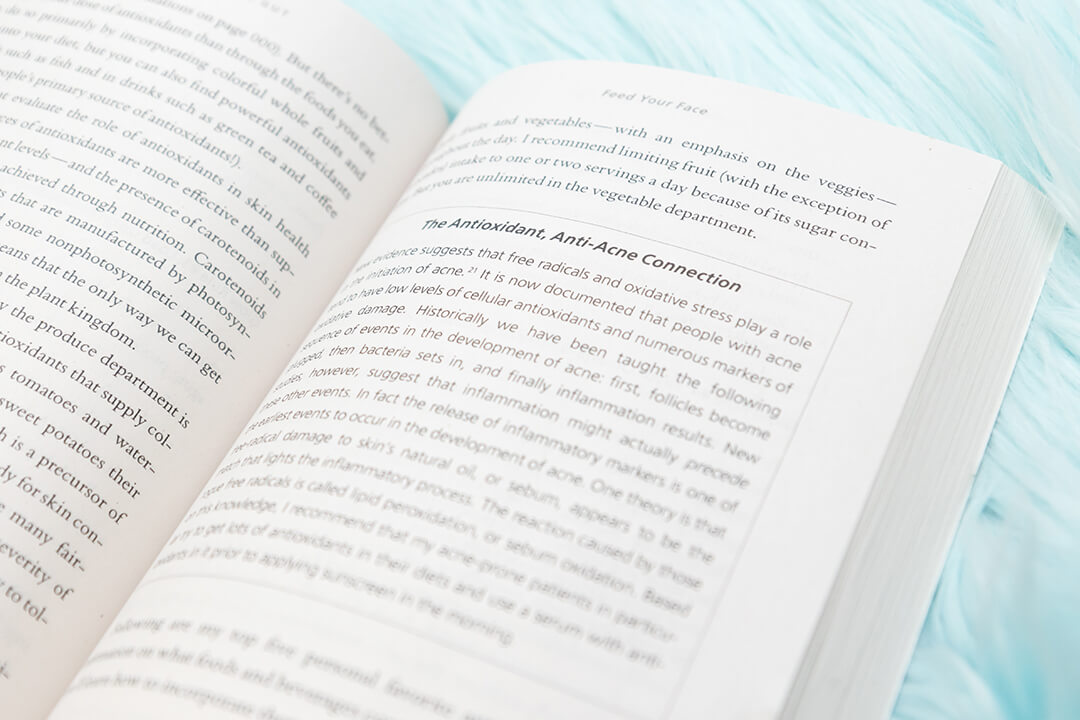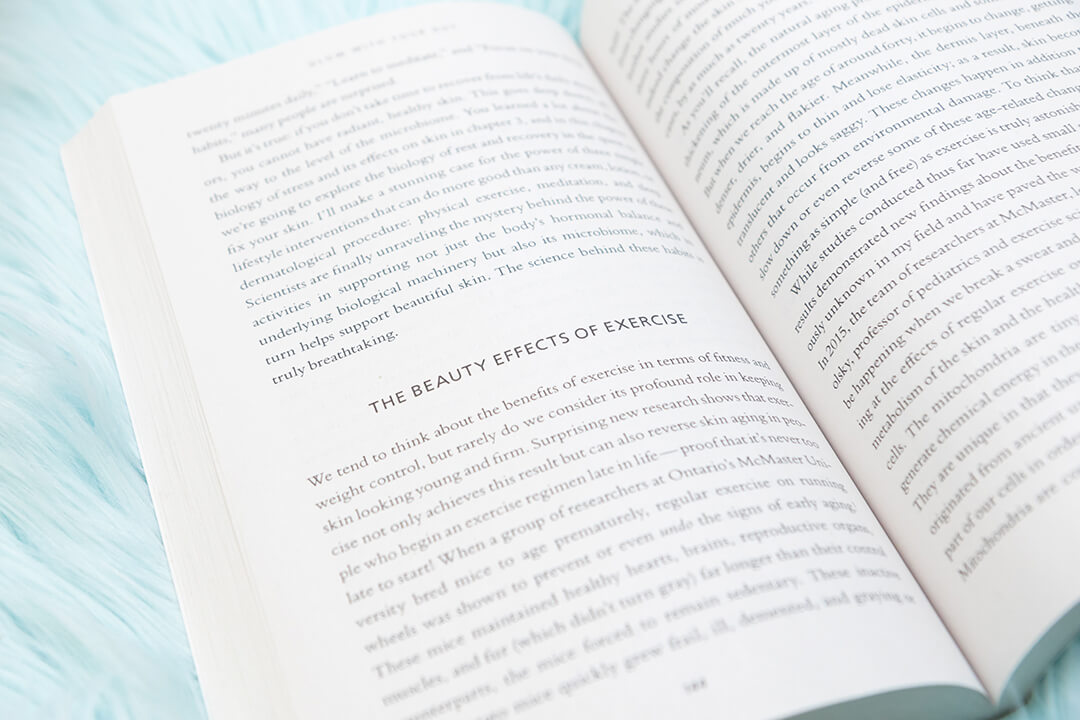

A moment of refreshing honesty. The beauty book aisle is not always the most riveting or groundbreaking area in the bookstore. That’s why I am so glad that I was introduced to this book and took the time to dive in! Dr. Whitney Bowe’s [easyazon_link identifier=”0316509825″ locale=”US” tag=”cosmeticswiki-20″]The Beauty of Dirty Skin [/easyazon_link] has the potential to be the Harry Potter of the beauty book aisle. It’s smart and savvy, and while it may not inspire a movie with Daniel Radcliffe, it certainly may work magic with your skin.
As a new mom, blogger, and bibliophile, I want to spend the precious few moments of down time I have effectively, efficiently, and in a way that empowers me to live a healthy, positive lifestyle. This book is inspiring me to do just that — I’m learning how to nourish my skin and body from the inside out and the outside in and with each chapter, I feel better informed to own my glow!
What I Learned from The Beauty of Dirty Skin
The gut-brain-skin connection is powerful. Ever notice your skin breaks out or you have an upset stomach when you are feeling stressed? Have you noticed that certain foods trigger acne breakouts or flares of your eczema or rosacea? It turns out that the gut, brain, and skin are connected and are able to “communicate” with each other. Our skin is a window into our overall health and what we eat and whether we sleep well, eat well, and work out all have a say in how we “face” the world. Dr. Bowe’s 21 Day action plan targets each of these three areas – your gut, your mind, and your skin – to get to the root of your skin issues to stop them from happening in the first place.
You can protect your skin with probiotics. Did you know that your body has its own good, warrior bugs? Did you
know they are living on your skin right now, while you are reading this sentence? [easyazon_link identifier=”0316509825″ locale=”US” tag=”cosmeticswiki-20″]The Beauty of Dirty Skin [/easyazon_link] introduced me to the word “microbiome” – the family of “bugs” (more specifically, bacteria, fungi, and viruses) that live both inside your body (your gut microbiome) and on your body, throughout your skin’s various layers, from its deep-down fat cushion to its epidermal cells on high. As I am learning, maintaining the health and balance of our microbiome is critical to maintaining our health. This is the quick version of how it works: Your skin’s warrior bugs (bacteria) protect your skin against inflammation, infection, premature aging, and even skin cancer! You can protect and nourish these warrior bugs by using probiotic skincare (and even “prebiotic” and “postbiotic” skincare, as Dr. Bowe explains), in addition to making small but meaningful changes in your cleansing rituals. Using gentle, pH balanced cleansers over antibacterial soaps or scrubs actually protects your skin against breakouts, rosacea flares, psoriasis, eczema, and even sensitive skin. And, as Dr. Bowe explains, be careful not to over exfoliate as this can disrupt the skin barrier and lead to red, blotchy, stinging skin. She recommends gently exfoliating twice a week maximum to avoid any unnecessary inflammation and disturbance in the surface microbiome. (Look at me, putting the super-strong cleansing products away for a while!)
Probiotics may help your skin look younger for longer as well. As I’m learning in [easyazon_link identifier=”0316509825″ locale=”US” tag=”cosmeticswiki-20″]The Beauty of Dirty Skin [/easyazon_link], I should incorporate a probiotic into my daily routine to encourage good bacteria to thrive on my skin. Moreover, topically, probiotics are live bacteria directly applied to the skin’s surface. Certain strains of probiotics can help to calm inflammation which can help with acne and rosacea. Probiotics also can release antimicrobial peptides (think of little powerful “missiles”) to destroy harmful viruses and fungi before they can stir up trouble in your skin. Some probiotics can even boost your skin’s production of ceramides which help to lock in your skin’s moisture, thereby protecting and strengthening your skin’s natural barrier. Our ceramides keep our skin looking young and smooth. Probiotics can also create free radical-fighting chemicals to support your skin’s own antioxidant supply, which has anti-aging benefits.
Variety is essential. If you’re type A like me, you may have a tendency to stick to certain rituals — the same vitamin supplement that infused you with energy a few years ago, for instance, or the skin care serum that made your skin glow like none other. But when it comes to infusing your diet and skin care regimen with probiotics, Dr. Bowe points out that you need variety, citing your skin’s natural “healthy rainforest of bugs”. She shows us that our skin is covered with trillions of micro-organisms, primarily bacteria, that are essential to healthy skin. There are upwards of one million of these bugs occupying a single square centimeter of your skin’s surface. By getting probiotics from a variety of sources, you’re helping to maintain your skin’s delicate balance of flora.
Switch your cleanser. Be careful of foaming cleansers, as foam is created by detergents that can irritate and strip the skin of its natural oils.
Simple food swaps. Dr. Bowe mentions avoiding milk-based products because of the whey and high glycemic index, which together can trigger inflammation in the skin. She recommends almond milk instead. Similarly, she also recommends avoiding high glycemic index foods like white bread, chips, or cold cereal, in lieu of low-glycemic, healthy carbs like sweet potatoes, quinoa, or multi-grain bread. And it goes without saying that high-sugar products like juice should be very limited if you want healthy, glowing skin. Sugar causes an aging and stiffening process in your cells called glycation – nothing we want to happen! So, opt for whole fruits or dark chocolate in moderation to satisfy your sweet tooth. (But the occasional splurge is okay, of course. It’s all about moderation and balance!)
Diet soda is not your skin’s friend. Artificial sweeteners in diet soda are destructive to the healthy bacteria which live in your gut which in turn leads to inflammation in your skin, so Dr. Bowe says to try to limit those whenever possible.
Why You Should Pick Up This Book
One of my favorite quotes is, “Knowledge without action is useless.” A lot of beauty books profess what to do, but they don’t tell you how to integrate beauty-enhancing products, lifestyle changes, and diet into what are already pretty jam-packed schedules. My favorite part of [easyazon_link identifier=”0316509825″ locale=”US” tag=”cosmeticswiki-20″]The Beauty of Dirty Skin [/easyazon_link] is that it includes a very reasonable three-week plan, including an easy-to-follow diet, exercise plan, and skin care regimen, that isn’t all that hard to implement. (Believe me, I have a six-week-old newborn — if I can do it, anyone can!)
Stay tuned for my 21-day challenge diary — and invitation for FutureDerm readers to join me — next week!

